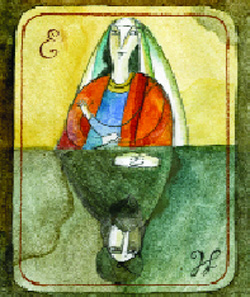Holidays
Purim
Commentary: Becoming Esther

The story of Purim—with its fairy-tale rendering of a rebellious queen and the beautiful Jewish woman who takes her place, of a king who is a buffoon and of an evil Jew-hater, of near slaughter, salvation and enshrined celebration—does not seem to offer much to Jews who dwell in Western democracies at the start of the third millennium.
And yet its central metaphor of ve-nahafokh hu—all is reversed—could not be more apt. In the Scroll of Esther that Jews continue to read on Purim (beginning Saturday evening March 15) what is high is cast down and what is demeaned is raised high, at times literally. Mordecai is besmirched to the king by the evil vizier Haman because he would not bow down, only to triumph, high on a steed led by the diminished Haman.
Haman, in turn, begins as second to the all-powerful king, enforcing his edict against the Jews of Persia, only to be brought low by Esther—and then hanged high on the gallows.
For us, the 20th century was afflicted by the most terrible and awe-filled ve-nahafokh hu; one third of our people and memory were murdered and almost a million expelled from Arab lands. In the same era, from the 19th through the 20th century, we built and were rebuilt by the most astonishing miracle, as we invented a language and created a state. That ancient Persia, now known as Iran, continues to threaten us with mass slaughter is yet another dark proof that we do not outgrow our inherited texts and the ways they continue to make meaning.
A microcosm of our ve-nahafokh hu story took place in June 1967. After the terrifying weeks that preceded the Six-Day War, when Israel was forsaken, came a miraculous victory, the dizzying swing from anguish to festivity that those of us who lived through it remember as if it were yesterday.
Today, nothing is as clear-cut as the seventh day appeared then. Only a few lone voices foresaw that from the horror of our enemies’ threat to throw us into the sea to our dazzling elimination of the Egyptian Air Force on the ground and the cry of “the Temple Mount is in our hands” could come the complexities of today—the crisis of instability of Israel’s neighbors, the still-unresolved borders from a war now almost 50 years old.
Reading the Scroll of Esther, I marvel at the way a story I once saw as a fable is an accurate portrait of Jewish fate: Brought low, raised high, cast down—and sometimes not even knowing high from low, good news from ill.
So what, in 2014, can one Jewish woman do?
It happens that the Scroll of Esther contains a galvanizing injunction, the words of Mordecai when he beseeches Esther to intervene with the king, even at the risk of her life, in order to save her people.
“For if you remain silent, salvation will come to the Jews from elsewhere.… But who knows if it was not precisely for this moment that you attained royalty?” says Mordecai.
Mordecai’s sentence is where the story of the Jews, so much larger than any one of us, intersects with our individual lives. Because each of us, every day, is summoned to act, in ways that either amplify the light in the world or increase darkness. Day by day, knowingly or not, we make that choice.
When the danger of annihilation was averted, says the Megilla, “for the Jews there was light, celebration, rejoicing and honor.” Ken tehiyeh lanu, “So may it be for us,” we add during the Havdala ceremony at the end of the Sabbath that separates light from darkness, holiness from dailiness.
So may it be for us. Happy Purim.
Nessa Rapoport is the author, most recently, of House on the River: A Summer Journey, a memoir of family and place. © 2013 by Nessa Rapoport. All rights reserved.










 Facebook
Facebook Instagram
Instagram Twitter
Twitter
Leave a Reply